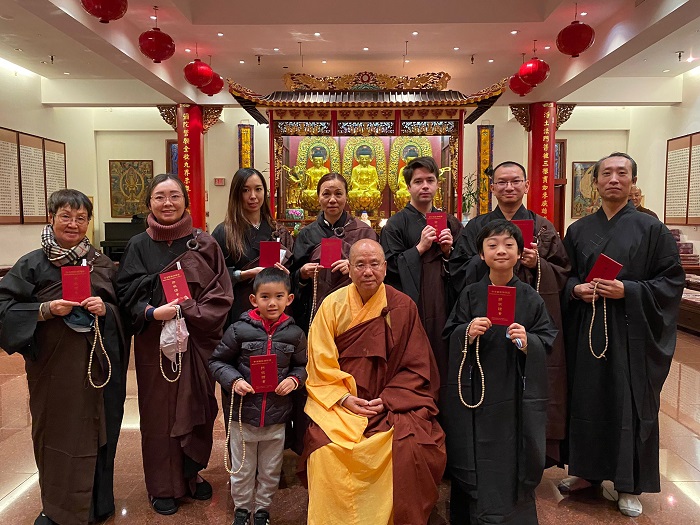Editor’s note: The author of this article is a Canadian Caucasian student who is very interested in Chinese culture and Buddhism. In order to gain a better understanding of Buddhism, he is currently living with the monks at our temple and experiencing monastic life.
By Jeremy James
I took refuge in the Buddha, Dharma and Sangha yesterday! Before the ceremony began, I picked up the couple who had travelled from the USA to attend, and brought them to the Hall of the Five Contemplations. We all put on our Hai Ching (a black robe) and got ready to gather at the Meditation Hall for the conversion ceremony. Once we arrived at the main hall of the Meditation Hall, we all found our places; each of us was assigned to stand in front of a meditation mat with his or her name on it. There were nine converts that day, and their friends and relatives sat to one side and watched.
A booklet was handed out to each recipient; this was to be recited at the time of the ceremony. The booklet contains the five precepts and an explanation of the object of conversion, i.e. conversion to the Buddha, the Dharma and the Sangha. The Buddha refers to Shakyamuni Buddha, which means enlightenment; the Dharma refers to all the righteous teachings of the Buddha, which means truth; and the Sangha refers to the monastic community that has converted to the Buddha, which means discipline. The five precepts we are to observe are “not to steal”, “not to speak delusionally”, “not to commit adultery”, “not to kill “and “not to drink alcohol”.
My preceptor, Venerable Guan Cheng, gave a detailed explanation of each of the elements of the precepts of conversion. Master said that the precept of “not stealing” was very difficult to keep because it was the most extensive in scope. For example, borrowing and forgetting to return is also a form of theft, so one must be very careful in keeping this precept. The precept of “not speaking presumptuously” is a little more self-explanatory, but it is also very difficult for many people to keep. “Not to kill “; The Master explained that this does not necessarily mean that one should not eat meat. As long as the object is not killed for us and we do not hear or see it being killed, it is thus “three pure meats”, for example, frozen meat can be eaten, but it is better not to eat it. The Master also clarified the meaning of “evil sexual intercourse”, which refers mainly to inappropriate relationships with men and women other than between husband and wife. The precept of “not drinking alcohol” is a kind of insurance precept, because when one drinks alcohol, one can easily commit the other four precepts, so one should not drink alcohol. These are some of the things that the Master explained to us during the conversion ceremony.
During the conversion, the Master faced us and sat in the middle of the front, while the converts were divided into two main columns of men and women, standing upright in front of the meditation cushion. Depending on the sounding of the dharma vessel, everyone was required to bow down once after each sutra. Some verses are recited three times, and each time they are recited they are to be worshipped once. Usually it was the Master who recited the scriptures once and then we responded by reciting them again. I was impressed by the fact that at the beginning of the conversion ceremony, Master specifically asked us to pay attention to the three pictures in the booklet, each of which showed a small human being meditating there while different forms of clouds were flowing above his head. In the first image, the clouds were beginning to form. In the second image, a large canopy appears in the clouds, while in the third image that cloud is then associated with the little man meditating. After explaining the content of each image, the Master had us bow down once, and as we did so, he also asked us to take a few seconds to imagine the different locations where the energy represented by the image was located, such as forming overhead, filling everything, and then entering inside our bodies, allowing us to have an induction with that great energy.
After taking the five precepts, the Venerable Masters came to help us put on the brown precept sashes, which meant that we had officially taken the five precepts. We will need to wear this precept sash when we eat our two meals in the day, and when we listen to the teachings of the Venerable Master. At the end of the ceremony, Master gave out a certificate to each of the recipients. A photograph was taken of the whole group and the meeting was satisfactorily dismissed.
Today’s conversion and ordination was a particularly memorable event. It could be considered to be one of the most interesting days since I arrived at the monastery.

